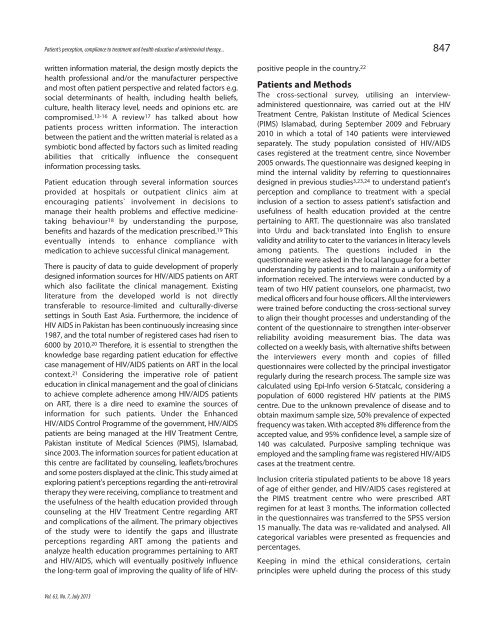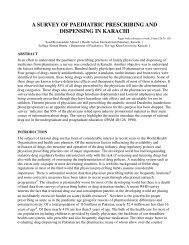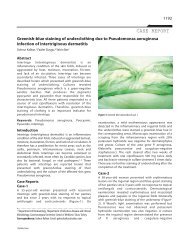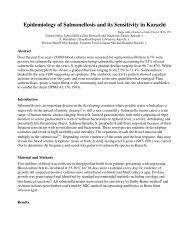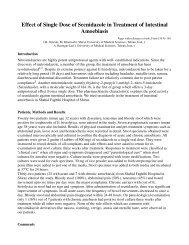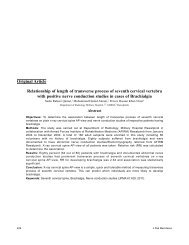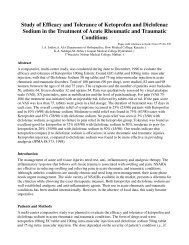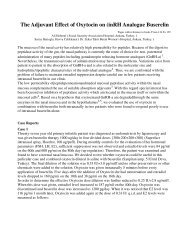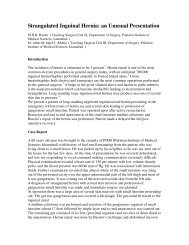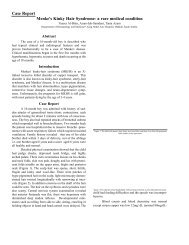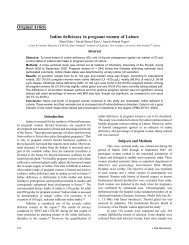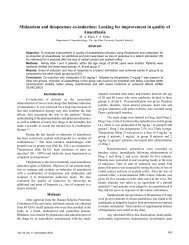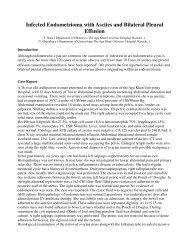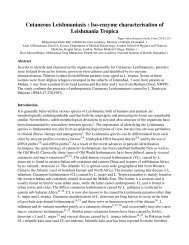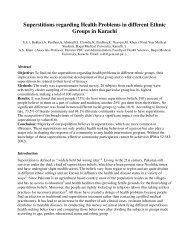ORIGINAL ARTICLE - Journal of Pakistan Medical Association
ORIGINAL ARTICLE - Journal of Pakistan Medical Association
ORIGINAL ARTICLE - Journal of Pakistan Medical Association
You also want an ePaper? Increase the reach of your titles
YUMPU automatically turns print PDFs into web optimized ePapers that Google loves.
Patient's perception, compliance to treatment and health education <strong>of</strong> antiretroviral therapy... 847<br />
written information material, the design mostly depicts the<br />
health pr<strong>of</strong>essional and/or the manufacturer perspective<br />
and most <strong>of</strong>ten patient perspective and related factors e.g.<br />
social determinants <strong>of</strong> health, including health beliefs,<br />
culture, health literacy level, needs and opinions etc. are<br />
compromised. 13-16 A review 17 has talked about how<br />
patients process written information. The interaction<br />
between the patient and the written material is related as a<br />
symbiotic bond affected by factors such as limited reading<br />
abilities that critically influence the consequent<br />
information processing tasks.<br />
Patient education through several information sources<br />
provided at hospitals or outpatient clinics aim at<br />
encouraging patients` involvement in decisions to<br />
manage their health problems and effective medicinetaking<br />
behaviour 18 by understanding the purpose,<br />
benefits and hazards <strong>of</strong> the medication prescribed. 19 This<br />
eventually intends to enhance compliance with<br />
medication to achieve successful clinical management.<br />
There is paucity <strong>of</strong> data to guide development <strong>of</strong> properly<br />
designed information sources for HIV/AIDS patients on ART<br />
which also facilitate the clinical management. Existing<br />
literature from the developed world is not directly<br />
transferable to resource-limited and culturally-diverse<br />
settings in South East Asia. Furthermore, the incidence <strong>of</strong><br />
HIV AIDS in <strong>Pakistan</strong> has been continuously increasing since<br />
1987, and the total number <strong>of</strong> registered cases had risen to<br />
6000 by 2010. 20 Therefore, it is essential to strengthen the<br />
knowledge base regarding patient education for effective<br />
case management <strong>of</strong> HIV/AIDS patients on ART in the local<br />
context. 21 Considering the imperative role <strong>of</strong> patient<br />
education in clinical management and the goal <strong>of</strong> clinicians<br />
to achieve complete adherence among HIV/AIDS patients<br />
on ART, there is a dire need to examine the sources <strong>of</strong><br />
information for such patients. Under the Enhanced<br />
HIV/AIDS Control Programme <strong>of</strong> the government, HIV/AIDS<br />
patients are being managed at the HIV Treatment Centre,<br />
<strong>Pakistan</strong> institute <strong>of</strong> <strong>Medical</strong> Sciences (PIMS), Islamabad,<br />
since 2003. The information sources for patient education at<br />
this centre are facilitated by counseling, leaflets/brochures<br />
and some posters displayed at the clinic. This study aimed at<br />
exploring patient's perceptions regarding the anti-retroviral<br />
therapy they were receiving, compliance to treatment and<br />
the usefulness <strong>of</strong> the health education provided through<br />
counseling at the HIV Treatment Centre regarding ART<br />
and complications <strong>of</strong> the ailment. The primary objectives<br />
<strong>of</strong> the study were to identify the gaps and illustrate<br />
perceptions regarding ART among the patients and<br />
analyze health education programmes pertaining to ART<br />
and HIV/AIDS, which will eventually positively influence<br />
the long-term goal <strong>of</strong> improving the quality <strong>of</strong> life <strong>of</strong> HIVpositive<br />
people in the country. 22<br />
Patients and Methods<br />
The cross-sectional survey, utilising an interviewadministered<br />
questionnaire, was carried out at the HIV<br />
Treatment Centre, <strong>Pakistan</strong> Institute <strong>of</strong> <strong>Medical</strong> Sciences<br />
(PIMS) Islamabad, during September 2009 and February<br />
2010 in which a total <strong>of</strong> 140 patients were interviewed<br />
separately. The study population consisted <strong>of</strong> HIV/AIDS<br />
cases registered at the treatment centre, since November<br />
2005 onwards. The questionnaire was designed keeping in<br />
mind the internal validity by referring to questionnaires<br />
designed in previous studies 3,23,24 to understand patient's<br />
perception and compliance to treatment with a special<br />
inclusion <strong>of</strong> a section to assess patient's satisfaction and<br />
usefulness <strong>of</strong> health education provided at the centre<br />
pertaining to ART. The questionnaire was also translated<br />
into Urdu and back-translated into English to ensure<br />
validity and atrility to cater to the variances in literacy levels<br />
among patients. The questions included in the<br />
questionnaire were asked in the local language for a better<br />
understanding by patients and to maintain a uniformity <strong>of</strong><br />
information received. The interviews were conducted by a<br />
team <strong>of</strong> two HIV patient counselors, one pharmacist, two<br />
medical <strong>of</strong>ficers and four house <strong>of</strong>ficers. All the interviewers<br />
were trained before conducting the cross-sectional survey<br />
to align their thought processes and understanding <strong>of</strong> the<br />
content <strong>of</strong> the questionnaire to strengthen inter-observer<br />
reliability avoiding measurement bias. The data was<br />
collected on a weekly basis, with alternative shifts between<br />
the interviewers every month and copies <strong>of</strong> filled<br />
questionnaires were collected by the principal investigator<br />
regularly during the research process. The sample size was<br />
calculated using Epi-Info version 6-Statcalc, considering a<br />
population <strong>of</strong> 6000 registered HIV patients at the PIMS<br />
centre. Due to the unknown prevalence <strong>of</strong> disease and to<br />
obtain maximum sample size, 50% prevalence <strong>of</strong> expected<br />
frequency was taken. With accepted 8% difference from the<br />
accepted value, and 95% confidence level, a sample size <strong>of</strong><br />
140 was calculated. Purposive sampling technique was<br />
employed and the sampling frame was registered HIV/AIDS<br />
cases at the treatment centre.<br />
Inclusion criteria stipulated patients to be above 18 years<br />
<strong>of</strong> age <strong>of</strong> either gender, and HIV/AIDS cases registered at<br />
the PIMS treatment centre who were prescribed ART<br />
regimen for at least 3 months. The information collected<br />
in the questionnaires was transferred to the SPSS version<br />
15 manually. The data was re-validated and analysed. All<br />
categorical variables were presented as frequencies and<br />
percentages.<br />
Keeping in mind the ethical considerations, certain<br />
principles were upheld during the process <strong>of</strong> this study<br />
Vol. 63, No. 7, July 2013


